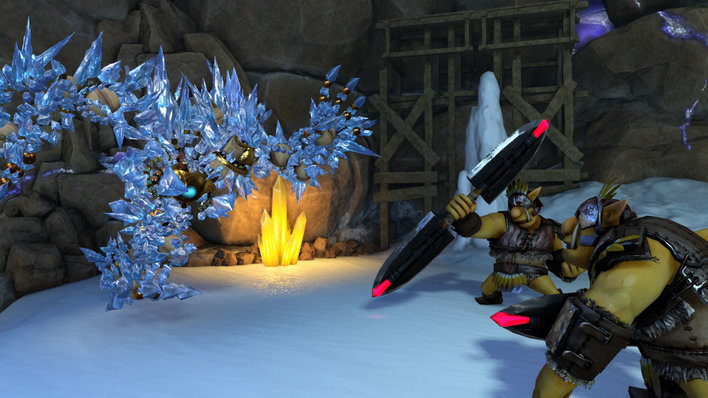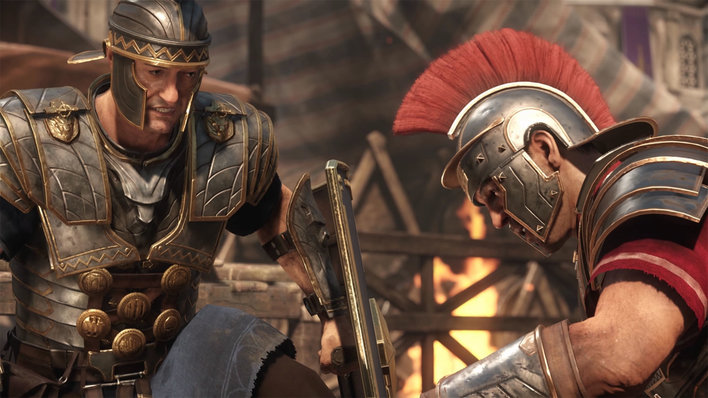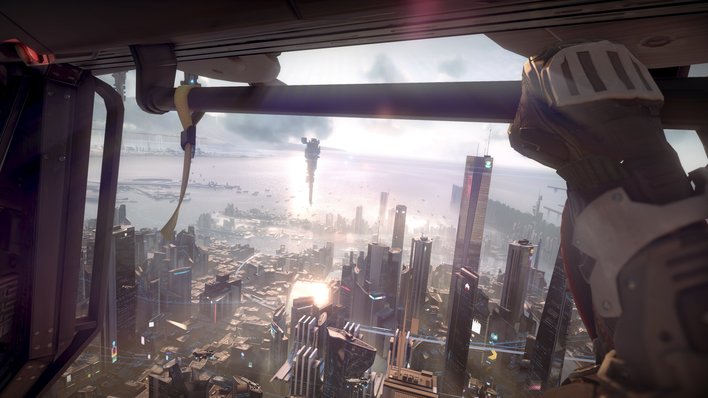It's an exciting time to be in the games industry at the moment - but a bit of a nerve-wracking one, too, to say the least. With the launch of two brand new consoles now only a few weeks away, the industry will soon be entering another "transition phase", its own version of a great migration, as people move from one lot of consoles onto the next, and they'll be crossing their fingers things go as smoothly as possible.
Of course, there are plenty of challenges that will have to be overcome before the majority make the move. Convincing people they need a new console in their life, when most launch titles are available (albeit in much less impressive versions) on consoles they already own will be an argument they'll have to win, as will proving that the console will have a steady supply of inventive, exciting games for those who like things outside of FIFA and Call of Duty. But perhaps the biggest potential barrier that could prevent people making the leap to the next-gen is one that also entirely self inflicted. That potential barrier is the pricing.
This new transition comes at a time when the pressure on pricing has never been greater. With development costs skyrocketing as graphics get more and more impressive, publishers have been forced to look at other ways of claiming back money - many of which have been incredibly unpopular with the consumers. Whether it was Microsoft threatening to block used game sales on the Xbox One (which they eventually backtracked on), the invention of "day one" downloadable content, where publishers hold back levels, characters, or costumes from the game, only to charge for it later, or the advent of free-to-play games, which sometimes gave performance boosts to people not based on their skill, but on the size of their wallet, it's safe to say that it's been an expensive time to play games, as publishers tried their best to create as many revenue streams as possible.
But today came the news that the launch titles for Sony's next console, the PS4, will come with an RRP of £59.99 - some £10 than the most expensive games went for on the PS3, and, perhaps more significantly, a whopping £20 price hike when compared to the PS3's launch titles. Although retailers don't seem all that enamoured by the news, having instead cut the price to anywhere between £50-53, it's hard to see that the games will ever get much lower than that, as there likely isn't much room left to manoeuvre.
It's worth mentioning here that this trend isn't just for Sony, as prices have been creeping ever upwards for some time now no matter what format you own. Disney Infinity, Disney's answer to Skylanders, may have been two years late to the Skylanders party, but they still decided the best way to be aggressive and steal market share would be to price their figures at £5 more than Skylanders cost. And charge those who want to play in co-op an extra £30. Prices on the Xbox Live Arcade have been slowly creeping upwards, making the £3.40 game a thing of the past (bar Telltale's episodic games) while Pokemon X cost an incredible £40 in GAME on launch day - some £10 more than a normal 3DS game, although this was seemingly GAME's idea rather than Nintendo's.

PS4 platformer Knack offers something for everyone - but will they be willing to pay £60?
The logic here would seem to be fairly straightforward, even if we don't necessarily agree with their thinking. The problem publishers face is that less people are buying games now, and at a console's launch, they'll be selling to a much smaller market - perhaps only a few hundred thousand people. These are also likely to be their most dedicated, and loyal customers - the ones who place their pre-orders months in advance, camp outside the shops waiting for the latest game to become available, and have been eagerly telling their friends about how much they're looking forward to the next consoles. They'll also likely be desperate for new games to play on their consoles - especially as neither the PS4 nor Xbox One is backwards compatible. So how do you reward your most loyal customers? By whacking a 50% price rise on your games.
Of course, the flip side of the argument doesn't seem to have been factored into the planning, which is that people have a limited amount of money. With energy bills rising as they are, and Christmas already an incredibly expensive time of year, people simply don't have that much spare cash to go around. And it's here that pricing is important. Bob and Sarah may well go out and buy a shiny new PS4, but whereas they might be tempted to buy a few extra games to go with it at £30 a pop, they'd be reluctant to by more than a single one at £60. It's what the marketing types like to call a "value proposition", and it's one of the things the games industry never seems to factor into its planning when they're busy worrying about how games sales have fallen. Yes, at a lower price point you'd have to sell more copies to make the same profit back, but you're also asking consumers to make a much less significant investment. At £50, you may only buy a single launch game. At £30, you might buy three, and all on day one. We know we would.
£50 isn't exactly a small amount of money to most people, so it's hardly surprising that most people want to make sure they don't blow it on a game that they're not sure if they'll even like. Publishers have long complained that it's too hard to launch brand new games, so they instead rely on sequels, because they know roughly how much it'll sell. For some reason, it doesn't seem to have dawned on anybody that perhaps the reason new games don't sell as well as established ones is that they're simply too expensive - it's easier to take a gamble on a new game for £30 than it is for £50.

Although it's a more expensive console, Microsoft have priced their launch games at £49.99 - which means Ryse can currently be found for just £38.
Perhaps what's more frustrating, though, is that the price hikes aren't a global thing. In the US, PS3 games were $59.99. For the PS4, they're $59.99. There has been no price hike - it's just us who've seen the prices jump by 50%. It feels even worse when you work out what the games should go for, if we had pricing parity with the US. A $59.99 game works out at just £37 - a price at which the launch games would fly off the shelves. Of course, a $59.99 game doesn't actually go for $59.99 in the US, as a sales tax is added on at the point of sale - but even taking into account VAT at our current 20% rate, it should weigh in at a £45 RRP - which most retailers would probably discount to £39.99 - not £59.99.
Ready for some more conversions? The next-gen consoles work out even worse. The Xbox One, which has an eye watering £425 price tag in the UK, costs $499 in the US - or just £311. Take into account our VAT at 20%, and you reach £373 - or £50 less than what we're actually being charged. The PS4 is $399 US, or 39,980 Yen, which both work out at roughly £250. Add on VAT, and you reach £300 - so there's another £50 tax for us, as a penalty for living in the UK. Perhaps it would be an easier pill to swallow if the weather was better, but it's interesting to note that there's no import tariffs on games consoles, either - so that can't explain the disparity. No matter what your platform of choice, if you pick up a console and two games at launch, you'll be paying £80 more than those living in the US - or roughly enough for another two games, if we had pricing parity. With that in mind, is it any wonder people are buying fewer games, and taking fewer risks?
Of course, the situation could be worse. We could always be Brazil. When the PS4 launches there, it'll set you back a grandmother-remortgaging £1,146, due to some rather business unfriendly import tariffs, which, as mentioned above, don't apply in the UK. Now, it seems, our friend the Euro is used as the gold standard for working out pricing, and the price we pay is calculated against that. In the world of console makers, a console that costs $399 costs 399 Euros, when the real figure should be 292 Euros (not including VAT). It's harder to take into account VAT across Europe, as it differs per country - but needless to say, when it comes to being ripped off, we really are all in this together - along with the rest of Europe.

The graphics may be fancier, but that doesn't explain why it costs more here than in the US. Unless we get better graphics too?
But perhaps the most worrying thing is what this will mean for the industry as a whole in the long run. Your average console-buyer may not even be aware of the disparity between UK and US prices - but they will be aware of how big a hole the purchase is going to leave in their pocket. If you can only afford to buy a single extra game, it'd hardly be surprising if people decided they'd be happier to just leave it, and wait for the prices to drop. And that could have a catastrophic knock on effect.
You see, confidence isn't exactly at a peak in the industry at the moment. Major publishers are struggling, some have even shut down, and no-one really seems to know how to go about increasing the sales of their games. As you can probably tell by looking at the launch line-ups, and seeing what a tiny handful of games are next-gen exclusives, as opposed to simply upgraded versions of games for the current consoles, publishers are more than hedging their bets. Several publishers (and developers) have told us that they're keeping an eye on how things do at the moment, holding off on green lighting games until they know how popular the new systems are, so they can go where the users, and the money is. Harmonix, who are toying with the idea of a new Rock Band game, is just one of them. No-one wants to put all their money behind making games for a brand new format without seeing how well that format will do - and that leads you to a risky game of chicken and egg.
People won't buy the new console if it doesn't have the right games - and people won't buy the console if those games aren't available for the right price. Retail tried the same with the Wii U, charging an extra tenner just because it was on a new console, and the Wii U has struggled, to say the least, ever since. No one can afford to have the same happen with the PS4 and Xbox One - that after the initial peak of interest, no-one buys any more, because the games are just too expensive. And that's the risk we're going to be running.
It's even more confusing when you consider how great Sony have been with pricing on their other formats. This Christmas, Tearaway, a charming new platformer from the creators of Little Big Planet will be available on the Vita. It's price? £20. At that price, Tearaway really should be a system seller for the console, not only because it looks incredible, but because it has a great price. Ratchet and Clank: Nexus on the PS3 is doing the same. A great looking platformer, the game will be launching for £20, and should fly off the shelves and into plenty of Christmas stockings. But where are the more affordable options on the PS4 (or the Xbox One)? Where's the incentive for people to buy a new console?
In some ways, it's easy to understand the reasoning. If you're nervous, or tetchy, your reactions tend to take over from your mind. If you're driving a car and heading for a crash, you'll jam your foot on the break. If you start skidding, you'll just press even harder, because it's so hard to separate your instinct from what you know you really need to do. And, metaphorically, it seems that's what's happening here. Sony need the PS4 to be a success. The rest of their business isn't exactly in the best of shapes - and they're obviously hoping that the PS4 will bring in the numbers - at least, outside America and Japan. But all it's really going to do is send the wrong message to consumers. As has been proven with taxes, will be proven with games. The higher you price them, the less money you'll bring in. If this is the status quo for the next-gen, it could be big mistake. At a the higher price point, there'll be less chance for new games to get established, less chance to become the next big thing, and it'll be harder for everyone who works on making games to make a living, at least in the UK and Europe. And that makes us worried.
We love playing games. We want nothing more than for the PS4, Xbox One, and Wii U to all be huge successes. With three thriving platforms comes competition, and when the platform holders compete with each other, consumers win. We get the most creative games, the most original games, and the industry reaches out to an audience it never knew existed, as it's forced to keep innovating. But what we really needed now was a price cut, not a price hike. For £35, or £40, the next-gen launch titles would fly off the shelves. For a £60 RRP, it's going to be a much bigger battle between your heart and wallet as you're summing your new purchase up. Why take a risk on a new machine when you can sit back and buy the finest the current gen (and the Wii U) has to offer for under £20 each? That's the biggest question that both format holders will have to answer this Christmas.












